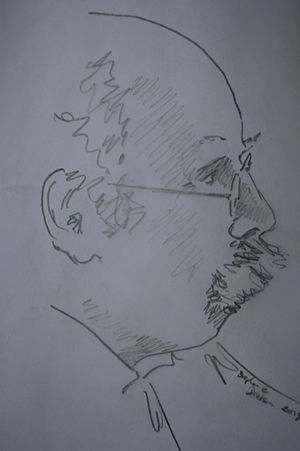Napier Shaw facts for kids
Quick facts for kids
Sir Napier Shaw
|
|
|---|---|
 |
|
| Born | 4 March 1854 |
| Died | 23 March 1945 (aged 91) |
| Nationality | British |
| Known for | Tephigram |
| Awards | Royal Medal (1923) Buys Ballot Medal (1923) |
| Scientific career | |
| Fields | Meteorologist |
Sir William Napier Shaw (born March 4, 1854 – died March 23, 1945) was a British scientist who studied the weather. He is famous for creating the tephigram. This is a special chart that helps scientists understand how air moves up and down in the atmosphere. He also led important weather groups, like the International Meteorological Committee and the Royal Meteorological Society.
Contents
The Life of Sir Napier Shaw
Early Life and Education
William Napier Shaw was born in Birmingham, England. His father, Charles Thomas Shaw, was a goldsmith. William went to King Edward's School, Birmingham for his early education.
Later, he studied at Cambridge University and then at the Humboldt University of Berlin in Germany.
Starting a Science Career
In 1879, Shaw returned to Britain. He began working at the Cavendish Laboratory at Cambridge University. He started as a "Demonstrator in Physics," which means he helped students with experiments. By 1887, he was teaching "Experimental Physics." In 1898, he became the Assistant Director of the lab.
In 1891, he was chosen to be a Fellow of the Royal Society. This is a special honor for top scientists in the UK.
Leading Weather Science
Shaw became very important in the field of meteorology (weather science). In 1900, he joined the Meteorological Council. From 1905 to 1907, he was the Director of the Meteorological Office. This office studies and predicts the weather for the country.
In 1907, he became the first Professor of Meteorology at Imperial College, London. This meant he was the first person to hold a special teaching position just for weather science at that university.
In 1911, he led the International Meteorological Committee. This group was an early version of the World Meteorological Organization. It helps countries work together on weather studies.
The Tephigram and Other Work
In 1915, Shaw created the tephigram. This diagram is still used today to understand how air behaves in the atmosphere. Later that year, King George V gave him the title of "Sir." This was a special honor for his contributions to science.
He also led the Royal Meteorological Society from 1918 to 1919. This is another important group for weather scientists.
Shaw also studied air pollution. He was one of the first people to look closely at smog and how it affects people's health. In 1925, he wrote a book called The Smoke Problem of Great Cities with John Switzer Owens.
Sir William Napier Shaw retired in 1924 when he was 70 years old. He passed away in London in 1945 at the age of 91.
Family Life
In 1885, William Napier Shaw married Sarah Jane Dugdale Harland. She passed away in 1923. They did not have any children.
Awards and Honors
Sir William Napier Shaw received several important awards for his work:
- In 1910, he was given the Symons Gold Medal from the Royal Meteorological Society.
- In 1923, he received a Royal Medal from the Royal Society.
- In 1924, he was invited to speak at the International Congress of Mathematicians in Toronto.

